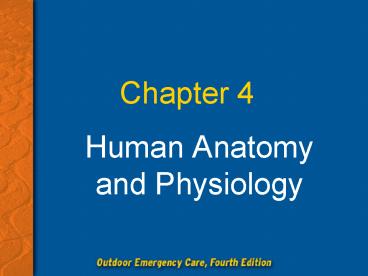Human Anatomy and Physiology - PowerPoint PPT Presentation
1 / 50
Title:
Human Anatomy and Physiology
Description:
Foot. 15. Chapter 4: Human Anatomy and Physiology. The Upper Extremity. Shoulder girdle ... Links the organs of the body to the central nervous system. ... – PowerPoint PPT presentation
Number of Views:873
Avg rating:3.0/5.0
Title: Human Anatomy and Physiology
1
Chapter 4
- Human Anatomy and Physiology
2
Objectives
- Identify and locate topographic terms on the
body. - Describe anatomy and functions of the major body
systems.
3
The Planes of the Body
- Anterior
- Posterior
- Midaxillary
- Midline
- Midclavicular line
4
Directional Terms
- Right and left
- Superior and inferior
- Lateral and medial
- Proximal and distal
- Superficial and deep
- Ventral and dorsal
- Palmar and plantar
- Apices and bilateral
5
Anatomic Positions
- Prone
- Supine
- Trendelenburgs position
- Fowlers position
6
The Skeletal System
- Gives form to the body
- Protects vital organs
- Consists of 206 bones
- Acts as a framework for attachment of muscles
- Designed to permit motion of the body
7
The Skull
8
The Neck
9
The Spinal Column
10
The Thorax
11
The Abdomen (1 of 2)
- The abdomen is the second major body cavity.
- It contains the major organs of digestion and
excretion.
12
The Abdomen (2 of 2)
13
The Pelvis
14
The Lower Extremity
- Hip
- Thigh
- Knee
- Leg
- Ankle
- Foot
15
The Upper Extremity
- Shoulder girdle
- Arm
- Elbow
- Forearm
- Wrist
- Hand
16
Joints
17
Functions of the Musculoskeletal System
- Gives the body shape
- Protects internal organs
- Provides for movement
- Consists of more than 600 muscles
18
Types of Muscle (1 of 2)
- Skeletal (voluntary) muscle
- Attached to the bones of the body
- Smooth (involuntary) muscle
- Carry out the automatic muscular functions of the
body
19
Types of Muscle (2 of 2)
- Cardiac muscle
- Involuntary muscle
- Has own blood supply and electrical system
- Can tolerate interruptions of blood supply for
only very short periods
20
The Respiratory System
21
Diaphragm
- Has characteristics of both voluntary and
involuntary muscles - Dome-shaped muscle
- Divides thorax from abdomen
- Contracts during inhalation
- Relaxes during exhalation
22
Breathing Process Inhalation
- Diaphragm and intercostal muscles contract,
increasing the size of the thoracic cavity. - Pressure in the lungs decreases.
- Air travels to the lungs.
23
Breathing Process Exhalation
- Diaphragm and intercostal muscles relax.
- As the muscles relax, all dimensions of the
thorax decrease. - Pressure in the lungs increases.
- Air flows out of the lungs.
24
Exchange of Oxygen and Carbon Dioxide
- Oxygen-rich air is delivered to alveoli with
inspiration. - Oxygen diffuses into the blood.
- The body does not use all the inhaled oxygen.
25
Control of Breathing
- Brain stem controls breathing.
- Increases breathing rate if the carbon dioxide
level in blood becomes too high - Hypoxic drive is a backup system.
- Activates when oxygen levels fall to stimulate
breathing
26
Normal Breathing Characteristics
- Normal rate and depth
- Regular rhythm
- Good breath sounds in both lungs
- Regular rise and fall movements in the chest
- Easy, not labored
27
Normal Breathing Rates
28
Recognizing Inadequate Breathing
- Pale or blue skin
- Cool, clammy skin
- Faster respiratory rate
- Irregular rhythm
- Labored breathing
- Muscle retractions
29
Infant and Child Anatomy
- Structures less rigid
- Airway smaller
- Tongue proportionally larger
- Dependent on diaphragm for breathing
30
The Circulatory System
31
The Heart
32
Blood Flow Through the Heart
33
Electrical Conduction System
- SA node
- AV node
- Purkinje fibers
34
Normal Heart Rates
35
Major Arteries and Veins
- Aorta
- Pulmonary
- Carotid
- Femoral
- Brachial
- Radial
- Superior vena cava
- Inferior vena cava
36
Components of Blood
- Plasma
- Red blood cells
- White blood cells
- Platelets
37
Physiology of the Circulatory System (1 of 2)
- Pulse
- The wave of blood through the arteries formed
when the left ventricle contracts - Can be felt where an artery passes over a bone
near the skin surface
38
Physiology of the Circulatory System (2 of 2)
- Blood pressure
- Amount of force exerted against walls of arteries
- Systole Left ventricle contracts
- Diastole Left ventricle relaxes
- Perfusion
- Circulation of blood within an organ or tissue
- If inadequate, the patient goes into shock.
39
The Nervous System
- The nervous system controls the bodys voluntary
and involuntary actions. - Somatic nervous system
- Regulates voluntary actions
- Autonomic nervous system
- Controls involuntary body functions
40
Central Nervous System (1 of 2)
41
Central Nervous System (2 of 2)
42
Peripheral Nervous System
- Links the organs of the body to the central
nervous system. - Sensory nerves carry information from the body to
the central nervous system. - Motor nerves carry information from the central
nervous system to the muscles of the body.
43
The Skin (1 of 2)
- Protects the body from the environment
- Regulates body temperature
- Transmits information from environment to the
brain
44
The Skin (2 of 2)
45
Endocrine System
- Complex message and control system
- Made up of 7 glands
- Glands produce and release hormones.
46
Endocrine Glands
- Adrenal
- Ovary
- Pancreas
- Parathyroid
- Pituitary
- Testes
- Thyroid
47
Digestive System
- Liver
- Bile ducts
- Small intestine
- Large intestine
- Appendix
- Rectum
- Mouth
- Salivary glands
- Oropharynx
- Esophagus
- Stomach
- Pancreas
48
Urinary System
49
Male Reproductive System
50
Female Reproductive System































